Food Processors
SharkNinja Becomes Independent Public Company
SharkNinja, Inc. has completed its previously announced separation from JS Global Lifestyle Company Limited. SharkNinja is now an independent public company, with its ordinary shares trading on the New York Stock Exchange under the ticker symbol “SN.” SharkNinja executives will rang the opening bell at the New York Stock Exchange to mark the milestone.
“Today is an exciting day for SharkNinja and is a testament to the dedication of the entire team and our shared commitment to positively impact people’s lives every day in every home around the world,” said Mark Barrocas, chief executive officer of SharkNinja. “Our success lies in understanding our consumers’ needs and rapidly developing innovative products to exceed their expectations. This approach has enabled us to build two billion-dollar brands, Shark and Ninja, by establishing leadership positions across numerous household product categories. Myself, the management team, and our associates around the world are all very excited that SharkNinja, headquartered in Boston, is now a public company listed on the New York Stock Exchange.”
Under the terms of the separation, shareholders who held JS Global ordinary shares on July 4, 2023, received a distribution of one SharkNinja ordinary share for every 25 ordinary shares of JS Global held by such shareholder as of the Record Date.
SharkNinja is a diversified, global product design and technology company that creates five-star rated lifestyle solutions through innovative products for consumers around the world. The company seeks to leverage its global, agile and cross-functional engineering know-how, product development and manufacturing expertise along with solutions-driven marketing to increase the efficiency, convenience and enjoyment of consumers’ daily tasks and improve everyday lives.
Powered by two global brands, Shark and Ninja, the company has a proven track record of bringing disruptive products to market, and developing one consumer solution after another has allowed SharkNinja to enter multiple product categories, driving significant growth and market share gains. The Company’s products are sold at key retailers, online and offline, and through distributors around the world.
For more news of interest to the housewares industry, subscribe to Kitchenware News & Housewares Review.
Voluntary Recall of Riveted Blades Contained in Cuisinart Food Processors
Conair Corporation, in cooperation with the U.S. Consumer Product Safety Commission (CPSC), announced a voluntary recall of the riveted blade contained in Cuisinart food processors. Affected consumers should stop using the riveted blade immediately unless otherwise instructed.
The food processor’s riveted blade can crack over time and small metal pieces of the blade can break off into the processed food. This may pose a laceration hazard to consumers. Consumers should immediately stop using the food processors’ riveted blade and contact Cuisinart for a free replacement blade.
This recall involves the riveted blades in Cuisinart food processors with model numbers that begin with the following: CFP-9, CFP-11, DFP-7, DFP-11, DFP-14, DLC-5, DLC-7, DLC-8, DLC-10, DLC-XP, DLC-2007, DLC-2009, DLC-2011, DLC-2014, DLC-3011, DLC-3014, EV-7, EV-10, EV-11, EV-14, KFP-7 and MP-14. The model number is located on the bottom of the food processor. The blades have four rivets and are silver-colored stainless steel and have a beige plastic center hub. Only food processors with four rivets in the blades are included in this recall. Cuisinart is printed on the front and on the bottom of the food processors. About 8 million food processors sold at department, gourmet and specialty stores nationwide and on various websites from July 1996 through December 2015 for between $100 and $350 are included in the recall.
Consumers may call Cuisinart toll-free at 877.339.2534 from 7 a.m. to 11 p.m. ET Monday through Friday and from 9 a.m. to 5 p.m. ET Saturday and Sunday, or visit online at www.cuisinart.com\recall. Consumers can click on Product Recalls at the bottom of the page for more information on the voluntary recall.
Hamilton Beach Stack & Snap 10-Cup Food Processor
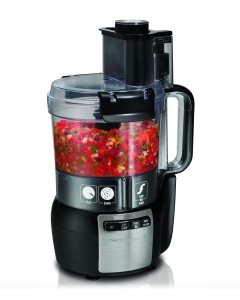 With the Stack & Snap™ Food Processor from Hamilton Beach®, the bowl is specially designed to fit directly on the base with no twisting required, and the lid snaps securely to the bowl with simple locking clips for safe operation. No more guessing whether it’s put together correctly, just stack and snap the parts into place. A simple function guide shows you which blade to use and which button to press to achieve the desired results. Features include a 10-cup capacity sealed bowl, Big Mouth® feed tube for less pre-cutting, reversible slice/shred disc and locking S-blade for chopping, mixing and pureeing, all driven by a powerful 450-watt motor. The bowl, lid and blades are dishwasher-safe.
With the Stack & Snap™ Food Processor from Hamilton Beach®, the bowl is specially designed to fit directly on the base with no twisting required, and the lid snaps securely to the bowl with simple locking clips for safe operation. No more guessing whether it’s put together correctly, just stack and snap the parts into place. A simple function guide shows you which blade to use and which button to press to achieve the desired results. Features include a 10-cup capacity sealed bowl, Big Mouth® feed tube for less pre-cutting, reversible slice/shred disc and locking S-blade for chopping, mixing and pureeing, all driven by a powerful 450-watt motor. The bowl, lid and blades are dishwasher-safe.
Suggested Retail Price: $59.99.
Cuisinart Elemental 11 Food Processor
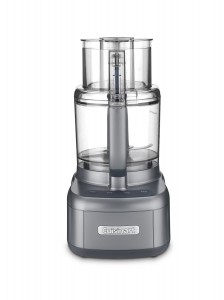 The sleek, new Elemental 11 Food Processor from Cuisinart allows home cooks to quickly and easily prep larger portions of ingredients for bigger meals. With an 11-cup work bowl, a stainless steel blade and two slicing/shredding discs, it’s the ultimate time-saver. The rubberized touch pad with pulse control offers the ease of use and versatility that will make it a favorite of creative home cooks. Additionally, its exclusive, patent-pending SealTight[TM] Advantage System seals the bowl, while its patented BladeLock System keeps blades securely in place when pouring out ingredients. With removable, dishwasher-safe parts, the BPA-free Elemental is easy to clean, and is available in gun metal, silver or white.
The sleek, new Elemental 11 Food Processor from Cuisinart allows home cooks to quickly and easily prep larger portions of ingredients for bigger meals. With an 11-cup work bowl, a stainless steel blade and two slicing/shredding discs, it’s the ultimate time-saver. The rubberized touch pad with pulse control offers the ease of use and versatility that will make it a favorite of creative home cooks. Additionally, its exclusive, patent-pending SealTight[TM] Advantage System seals the bowl, while its patented BladeLock System keeps blades securely in place when pouring out ingredients. With removable, dishwasher-safe parts, the BPA-free Elemental is easy to clean, and is available in gun metal, silver or white.
Suggested Retail Price: $149.
Small Appliances for Healthy Eaters
The next edition of the U.S. Department of Agriculture’s Dietary Guidelines for Americans is due to be issued this year, but the broad outline for those guidelines has already been released in the form of the Scientific Report of the 2015 Dietary Guidelines Advisory Committee. Among the highlights of the report: suggestions for more urging for Americans to modify their diets and get more exercise; more pressure on the food industry to reformulate food products in a healthier direction; and a tax on sugar-sweetened beverages, snack foods and desserts that could be used to fund obesity prevention programs.
The U.S. government uses the Dietary Guidelines as the basis of its food assistance programs, nutrition education efforts and decisions about national health objectives, including the menu planning for the National School Lunch Program. Dietary Guidelines for Americans were first released in 1980 and have been updated every five years since. The point of this report from the advisory committee is to inform the next edition of the Dietary Guidelines.
Today, about half of all American adults have one or more preventable chronic diseases related to their diets and about two thirds of American adults are overweight or obese. These two conditions have been highly prevalent for more than two decades, and few, if any, improvements in consumers’ food choices have been seen in recent decades, the report says, adding that a food environment epitomized by an abundance of highly-processed, convenient, lower-cost, energy-dense, nutrient-poor foods makes it particularly challenging to persuade Americans to change their ways.
In order to comply with the Dietary Guidelines, Americans may have to reduce screen time, eat at fast food restaurants less often, eat at home with their families more often and monitor their own diet and body weight. For this approach to work, it would also be essential for Americans, particularly low-income Americans, to have access to healthy and affordable food choices that respect their cultural preferences.
The housewares industry is already responding to the increased attention to healthy nutrition that the new dietary guidelines will prompt with small appliances that can help home cooks approach their healthy eating goals with convenience and added control. Food dehydrators are an example.
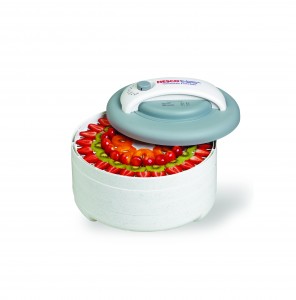 “The reason people might want to use a dehydrator is because that way they know what’s in their food,” says Darlene Schmitz, Vice President of Sales & Marketing for The Metal Ware Corporation, manufacturers of Nesco dehydrators. “When you dehydrate, you don’t add anything to the food, generally.… The natural sugars that are in the food actually concentrate as the food shrinks because the food gets smaller, so the food actually tastes sweeter than it does in the raw state. That way, you know where the food came from. You bought it at the store, you bought it at a farmers market, you grew it yourself – and you know exactly what’s in it.”
“The reason people might want to use a dehydrator is because that way they know what’s in their food,” says Darlene Schmitz, Vice President of Sales & Marketing for The Metal Ware Corporation, manufacturers of Nesco dehydrators. “When you dehydrate, you don’t add anything to the food, generally.… The natural sugars that are in the food actually concentrate as the food shrinks because the food gets smaller, so the food actually tastes sweeter than it does in the raw state. That way, you know where the food came from. You bought it at the store, you bought it at a farmers market, you grew it yourself – and you know exactly what’s in it.”
Schmitz says Nesco has been using the dehydrators at shows to make kale chips, with just a little olive oil and lemon pepper added, that are surprisingly a big hit with kids. Another favorite is sun-dried tomatoes, with a touch of Italian seasonings and olive oil, that also come out like a chip. Many customers use the appliance to make jerky, and Nesco also has a jerk gun for this use. A tray called a fruit roll sheet can be used for liquids or semi-liquids to make a fruit roll-up type treat. Users can even dehydrate soup, spaghetti sauce, or chili and then reconstitute it later. Dog treats are another possibility.
Nesco has been making dehydrators for over 40 years now and has 11 different models to choose from, ranging in price from $39 to $179. Schmitz says any of the models with an adjustable thermostat would make a nice entry level choice are any of the models that have an adjustable thermostat because this allows customers to figure out the setting they like best for produce versus meats, whereas other basic models have a set temperature. The Snackmaster[R] Encore Food Dehydrator (FD-61) comes with four trays, including a fruit roll sheet, and is adjustable to up to 12 trays that are purchased separately. It has an adjustable thermostat that ranges from 95 to 160 degrees Fahrenheit, 500 watts of drying power, and a suggested retail price of $69.99.
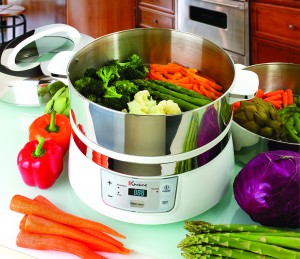 For consumers who are concerned about the amount of fat in their diet, Euro Cuisine’s Stainless Steel 2-Tier Electric Steamer allows home cooks to steam up a complete meal in the electric steamer’s two included 8.5-quart baskets. Vegetables, seafood and poultry can all be made at the same time with the different flavors on each tray. An easy-to-read LCD display features a built-in 90-minute timer, and the unit also features a built-in warming function. The Electric Steamer has a suggested retail price of $159.99.
For consumers who are concerned about the amount of fat in their diet, Euro Cuisine’s Stainless Steel 2-Tier Electric Steamer allows home cooks to steam up a complete meal in the electric steamer’s two included 8.5-quart baskets. Vegetables, seafood and poultry can all be made at the same time with the different flavors on each tray. An easy-to-read LCD display features a built-in 90-minute timer, and the unit also features a built-in warming function. The Electric Steamer has a suggested retail price of $159.99.
The new Zojirushi Fish Roaster cooks fish without the funk, which will appeal to those who are looking for ways to incorporate more unsaturated fats and Omega 3 fatty acids into their diets. The countertop unit has a platinum catalytic filter to eliminate up to 90 percent of smoke and odor components. A stainless steel roasting rack directs excess oils and fats away from food. The Fish Roaster also features an adjustable timer up to 30 minutes, a flip-open lid for easy operation and a food server for easy removal of foods. It has a suggested retail price of $200.
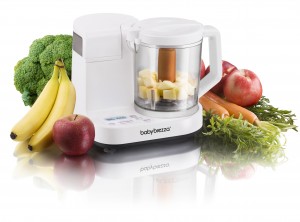 Health conscious consumers can also ensure their baby’s food is healthy too with Baby Brezza’s new One Step Baby Food Maker Glass that launches this month. This latest version of the One Step Baby Food Maker will be the only model on the market with a large 4-cup capacity glass bowl. Using a patented dual steam and blend functionality, users can make thier own baby food with the push of a single button. Baby Brezza will cook and blend the food at the same time, or users can choose from the steam only or blend only settings. The one bowl design eliminates the need to transfer hot foods into a separate blender, while a removable water tank simplifies filling and cleaning. The One Step Baby Food Maker Glass has a suggested retail price of $159.99.
Health conscious consumers can also ensure their baby’s food is healthy too with Baby Brezza’s new One Step Baby Food Maker Glass that launches this month. This latest version of the One Step Baby Food Maker will be the only model on the market with a large 4-cup capacity glass bowl. Using a patented dual steam and blend functionality, users can make thier own baby food with the push of a single button. Baby Brezza will cook and blend the food at the same time, or users can choose from the steam only or blend only settings. The one bowl design eliminates the need to transfer hot foods into a separate blender, while a removable water tank simplifies filling and cleaning. The One Step Baby Food Maker Glass has a suggested retail price of $159.99.


You must be logged in to post a comment.